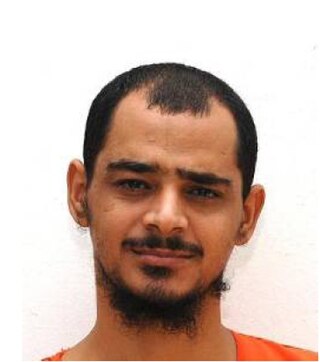
The Dasht-i-Leili massacre occurred in December 2001 during the U.S. invasion of Afghanistan when 250 to 2,000 Taliban prisoners were shot and/or suffocated to death in metal shipping containers while being transferred by Junbish-i Milli soldiers under the supervision of forces loyal to General Rashid Dostum from Kunduz to Sheberghan prison in Afghanistan. The site of the graves is believed to be in the Dasht-e Leili desert just west of Sheberghan, in the Jowzjan Province.
About six months after the United States invasion of Iraq of 2003, rumors of Iraq prison abuse scandals started to emerge.
Mullah Habibullah was an Afghan who died on December 4, 2002 while in US custody at the Bagram Collection Point, a US military detention center in Afghanistan. His death was one of those classed as a homicide, though the initial military statement described his death as due to natural causes.
Abed Hamed Mowhoush was an air vice-marshal believed to be in command of the transport, logistics and airlifting division of the Iraqi Air Force during the regime of Saddam Hussein immediately prior to the 2003 Invasion of Iraq, until his surrender to United States forces on 10 November 2003. He died on 26 November 2003 while in U.S. custody at the Al-Qaim detention facility approximately 200 miles (320 km) northwest of Baghdad, following a 16-day period of detention.

In 2005, The New York Times obtained a 2,000-page United States Army investigatory report concerning the homicides of two unarmed civilian Afghan prisoners by U.S. military personnel in December 2002 at the Bagram Theater Internment Facility in Bagram, Afghanistan and general treatment of prisoners. The two prisoners, Habibullah and Dilawar, were repeatedly chained to the ceiling and beaten, resulting in their deaths. Military coroners ruled that both the prisoners' deaths were homicides. Autopsies revealed severe trauma to both prisoners' legs, describing the trauma as comparable to being run over by a bus. Seven soldiers were charged in 2005.

Dilawar, also known as Dilawar of Yakubi, was an Afghan farmer and taxi driver who was tortured to death by US Army soldiers at the Bagram Collection Point, a US military detention center in Afghanistan.
The Church report on detainee interrogation and incarceration is a report completed under the direction of Vice Admiral Albert T. Church, an officer in the United States Navy. Church was then the Naval Inspector General.
Fashad Mohamed was an Iraqi who died in custody on April 5, 2004. He was alleged to have been captured and beaten by SEAL team 7. He was hooded, sleep deprived, and soaked with extremely hot and cold water. When he was finally allowed to sleep he did not wake up.

Adnan Farhan Abdul Latif, also known as Allal Ab Aljallil Abd al Rahman, was a Yemeni citizen imprisoned at the U.S. military prison at Guantanamo Bay, Cuba, from January 2002 until his death in custody there, ruled a suicide.

Mullah Mohammad Fazl is a member of the Taliban militant group and the First Deputy Defense Minister of the Islamic Emirate of Afghanistan, having assumed the role on 7 September 2021. He also served in the position during the previous Taliban government (1996–2001).

Taxi to the Dark Side is a 2007 American documentary film directed by Alex Gibney, and produced by Gibney, Eva Orner, and Susannah Shipman. It won the 2007 Academy Award for Best Documentary Feature. It focuses on the December 2002 killing of an Afghan taxi driver named Dilawar, who was beaten to death by American soldiers while being held in extrajudicial detention and interrogated at a black site at Bagram air base.
The Parwan Detention Facility is Afghanistan's main military prison. Situated next to the Bagram Air Base in the Parwan Province of Afghanistan, the prison was built by the U.S. during the George W. Bush administration. The Parwan Detention Facility, which housed foreign and local combatants, was maintained by the Afghan National Army.
Yaqubi is the center of Sabari District in Khost Province, Afghanistan. It is located on 33.4608°N 69.99°E at 1,113 m altitude in the southeastern part of the district.
Mohamed Farag Ahmad Bashmilah is a citizen of Yemen who is reported to have been a subject of the United States' controversial extraordinary rendition program. The American Civil Liberties Union states that he was apprehended by the Jordanian General Intelligence Department and tortured and interrogated for days, in Jordan, where he was: "turned over to agents who beat, kicked, diapered, hooded and handcuffed him before secretly transporting him to the U.S. Air Force base in Bagram, Afghanistan." They report that Bashmillah was held in extrajudicial detention in the United States' Bagram Theater Internment Facility, and the CIA network of black sites.
Joshua R. Claus is a former member of the United States Army, whose unit was present at both Iraq's Abu Ghraib and at the Bagram Theater Detention Facility in Afghanistan, and was the first interrogator of Guantanamo detainee Omar Khadr. In 2005, he was found guilty of maltreatment and assault against an Afghanistan detainee who later died.

Tina Monshipour Foster is an Iranian-American lawyer and director of the International Justice Network.
Parkhudin is a citizen of Afghanistan who was held in extrajudicial detention in the Bagram Collection Point and in the United States Guantanamo Bay detainment camps in Cuba. His Guantanamo Internment Serial Number was 896.
On January 16, 2010, the United States Department of Defense complied with a court order and made public a heavily redacted list of the detainees held in the Bagram Theater Internment Facility. Detainees were initially held in primitive, temporary quarters, in what was originally called the Bagram Collection Point, from late 2001. Detainees were later moved to an indoor detention center until late 2009, when newly constructed facilities were opened.

Abdul Basir was a citizen of Afghanistan who died while in the custody of Afghanistan's intelligence service the National Directorate of Security (NDS).







